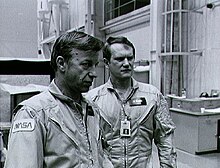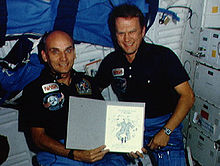American astronaut (1937–2023)
| Bo Bobko | |
|---|---|
 Bobko in 1979 Bobko in 1979 | |
| Born | Karol Joseph Bobko (1937-12-23)December 23, 1937 New York City, New York, U.S. |
| Died | August 17, 2023(2023-08-17) (aged 85) Half Moon Bay, California, U.S. |
| Education | |
| Awards | Distinguished Flying Cross |
| Space career | |
| NASA astronaut | |
| Rank | Colonel, USAF |
| Time in space | 16d 2h 3m |
| Selection | |
| Missions | STS-6 STS-51-D STS-51-J |
| Mission insignia | |
| Retirement | January 1, 1989 |
Karol Joseph "Bo" Bobko (December 23, 1937 – August 17, 2023) was an American aerospace engineer, U.S. Air Force officer, test pilot, and a USAF and NASA astronaut. Bobko was the first graduate of the U.S. Air Force Academy to travel in space and the first person to fly on three different space shuttles across three different missions: STS-6, STS-51-D, STS-51-J.
Early life and education
Colonel Bobko was born on December 23, 1937, in Queens, New York, to a family with Polish and Lithuanian roots. He graduated from Brooklyn Technical High School in 1955 before receiving a Bachelor of Science degree from the United States Air Force Academy in 1959. In 1970, he earned a Master of Science degree in aerospace engineering from the University of Southern California.
Military service
Bobko was a member of the first graduating class of the U.S. Air Force Academy. Subsequent to receiving his commission and navigator rating, he attended pilot training at Bartow Air Base, Florida, and Vance Air Force Base, Oklahoma. He completed his flight training and received his pilot wings in 1960.
From 1961 to 1965, he flew F-100 and F-105 aircraft while assigned as a pilot with the 523d Tactical Fighter Squadron at Cannon Air Force Base, New Mexico, and the 336th Tactical Fighter Squadron at Seymour Johnson Air Force Base, North Carolina. He attended the Aerospace Research Pilot School at Edwards Air Force Base, California, and was assigned as an astronaut to the USAF Manned Orbiting Laboratory (MOL) program in 1966.
Bobko logged over 6,600 hours flight time in the F-100, F-104, F-105, T-33, T-38, and other aircraft.
NASA career
Bobko became part of NASA Astronaut Group 7 in September 1969 after the cancellation of the Manned Orbiting Laboratory (MOL) program. He was a crewmember on the highly successful Skylab Medical Experiment Altitude Test (SMEAT) – a 56-day ground simulation of the Skylab mission, enabling crewmen to collect medical experiments baseline data and evaluate equipment, operations and procedures.
Bobko was a member of the astronaut support crew for the Apollo–Soyuz Test Project (ASTP). This historic first international manned space flight was completed in July 1975. Subsequently, he was a member of the support crew for the Space Shuttle Approach and Landing Tests conducted at Edwards Air Force Base. He served alternately as CAPCOM and prime chase pilot during these Approach and Landing Test (ALT) flights.
In preparation for the first flight of Columbia (STS-1) Bobko served as the lead astronaut in the test and checkout group at Kennedy Space Center.
A veteran of three space flights, Bobko logged a total of 386 hours in space. He was the first graduate of the US Air Force Academy to travel in space and the first astronaut to fly on three different shuttle missions. He was the pilot on STS-6 (April 4–9, 1983); and was the mission commander on STS-51-D (April 12–19, 1985) and STS-51-J (October 3–7, 1985).
Spaceflight experience
Main article: STS-6
Bobko was pilot for STS-6, which launched from Kennedy Space Center in Florida, on April 4, 1983. During the maiden voyage of Challenger, the crew deployed a large communications satellite (TDRS-1) and the rocket stage (Inertial Upper Stage) required to boost it to geosynchronous orbit. The STS-6 crew also conducted the first Shuttle spacewalk (EVA) and additionally conducted numerous other experiments in materials processing and the recording of lightning activities from space. There were also three Getaway Specials activated on the flight. After 120 hours of orbital operations, Challenger landed on the concrete runway at Edwards Air Force Base in California, on April 9, 1983.
Main article: STS-51-D
On his second mission, Bobko was the commander of STS-51-D which launched from Kennedy Space Center on April 12, 1985. The mission was to deploy two communications satellites, perform electrophoresis and echocardiograph operations in space, in addition to accomplishing other experiments. When one of the communications satellites malfunctioned, the first unscheduled spacewalk was made to activate the satellite which required rendezvous and operations with the remote manipulator arm. After 168 hours of orbital operations, Discovery landed on Runway 33 at Kennedy Space Center on April 19, 1985.
Main article: STS-51-JBobko's final flight was as commander of STS-51-J, the second Space Shuttle Department of Defense mission, which launched from Kennedy Space Center on October 3, 1985. This mission carried classified payloads for the Department of Defense and was the second time that a Shuttle mission was used solely for Department of Defense activities. This was the maiden voyage of Atlantis. After 98 hours of orbital operations, Atlantis landed on Edwards Air Force Base Lakebed Runway 23 on October 7, 1985. Bobko became the first person to fly on three different Space Shuttles. He was the only astronaut to have flown on the maiden flights of two Space Shuttles.
Post-NASA career
In 1988, Bobko retired from NASA and the Air Force to join the firm of Booz Allen Hamilton, in Houston, Texas. At Booz Allen he was a principal and managed efforts dealing with human space flight. His areas of emphasis were: high performance training simulation, hardware and software systems engineering, spacecraft checkout and testing, space station development and program integration.
In 2000, Bobko joined SPACEHAB, Inc. in Houston, Texas, where he was Vice President for Strategic Programs. He led an organization that develops concepts, processes and hardware for future spaceflight applications. In 2005, Bobko joined Science Applications International Corporation (SAIC) as Program Manager for the NASA Ames Research Center Simulation Laboratories (SimLabs) contract.
Personal life and death
Bobko was married to F. Dianne Welsh and had a daughter and a son. He resided with his wife in Half Moon Bay, California.
Bobko died of complications of an unspecified degenerative disease of the nervous system in Half Moon Bay on August 17, 2023, at age 85.
Awards and honors
- Defense Superior Service Medal
- Legion of Merit
- Distinguished Flying Cross
- Defense Meritorious Service Medal
- Meritorious Service Medals (2; 1970 and 1979)
- NASA Exceptional Service Medals (2)
- NASA Space Flight Medals (3)
- Johnson Space Center Group Achievement Awards (6)
- Air Force Academy Jabara Award (1983)
- Cradle of Aviation Museum Long Island Air & Space Hall of Fame
- U.S. Astronaut Hall of Fame (May 7, 2011).
- Fellow of the Society of Experimental Test Pilots (2020)
See also
References
- "MEN IN THE NEWS: PAUL J. WEITZ". New York Times. April 5, 1983. Retrieved February 8, 2019.
- ^ "KAROL J. BOBKO (COLONEL, USAF, RET.) NASA ASTRONAUT (FORMER)" (PDF). NASA. January 2020. Retrieved January 9, 2021.
- Lecture of NASA Astronaut Karol J. Bobko
- "Visit of Dr. Simon P. Worden, Director of the NASA Ames Research Center, and COL Karol J. Bobko, Former NASA Astronaut". Archived from the original on April 6, 2012. Retrieved November 15, 2011.
- "Trojans in Space". University of Southern California. Retrieved January 16, 2018.
- ^ Pearlman, Robert (January 13, 2011). "Shuttle Commander, Record Spacewalker Chosen for Astronaut Hall of Fame". Space.com. Retrieved January 8, 2018.
- "The Contrails: Notable Graduates". U.S. Air Force Academy Public Affairs. April 26, 2016. Retrieved January 17, 2018.
- "THIS IS WHY THE AIR FORCE ACADEMY IS LEADING THE WAY IN SPACE". US Air Force Academy. October 12, 2017. Archived from the original on December 11, 2018. Retrieved December 11, 2018.
- "STS-6". NASA. November 23, 2007. Retrieved January 16, 2018.
- "STS-51D". NASA. February 18, 2010. Retrieved January 16, 2018.
- Blakeslee, Sandra. "Astronauts return from secret" (sic) The New York Times, October 8, 1985.
- ^ Coast's own astronaut dies in HMB at age 85, Pacifica Tribune
- Sandomir, Richard (August 24, 2023). "Karol Bobko, First to Pilot the Challenger Into Space, Dies at 85". The New York Times. ISSN 0362-4331. Retrieved September 14, 2023.
- "Karol 'Bo' Bobko, astronaut who flew 3 shuttle missions, dies at 85". Collect Space. August 18, 2023. Retrieved August 20, 2023.
- ^ Shayler, David; Burgess, Colin (June 19, 2017). The Last of NASA's Original Pilot Astronauts: Expanding the Space Frontier in the Late Sixties. Springer. p. 364.
- Bleyer, Bill (May 17, 2010). "Cradle of Aviation hall of fame adds 3 inductees". Newsday. Retrieved January 8, 2018.
- Todd Halvorson (January 11, 2011). "2 head for U.S. Astronaut Hall of Fame". Florida Today. Brevard County, Florida. Archived from the original on August 9, 2014. Retrieved January 12, 2011.
- "SETP Fellow Classes". The Society of Experimental Test Pilots. Retrieved August 24, 2023.
External links
| NASA Astronaut Group 7, 1969 | |||||||
|---|---|---|---|---|---|---|---|
| NASA Astronaut Group 6 ← NASA Astronaut Group 7 → NASA Astronaut Group 8 | |||||||
| |||||||
- 1937 births
- 1983 in spaceflight
- 1985 in spaceflight
- 2023 deaths
- American aerospace engineers
- American people of Lithuanian descent
- American people of Polish descent
- American test pilots
- Aviators from New York (state)
- Booz Allen Hamilton people
- Brooklyn Technical High School alumni
- Businesspeople from Houston
- Engineers from New York City
- Military personnel from New York City
- NASA people
- People from Queens, New York
- Recipients of the Defense Superior Service Medal
- Recipients of the Distinguished Flying Cross (United States)
- Recipients of the Jabara Award
- Recipients of the Legion of Merit
- Recipients of the Meritorious Service Medal (United States)
- Recipients of the NASA Exceptional Service Medal
- Space Shuttle program astronauts
- U.S. Air Force Test Pilot School alumni
- United States Air Force Academy alumni
- United States Air Force astronauts
- United States Air Force officers
- United States Astronaut Hall of Fame inductees
- USC Viterbi School of Engineering alumni